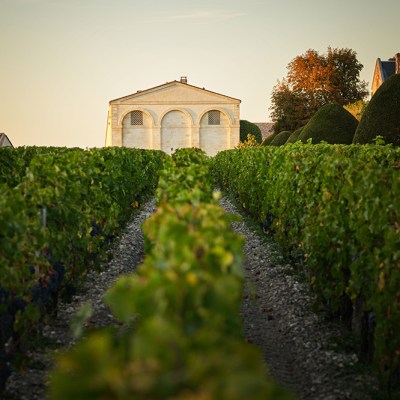From the October 2022 issue of Apollo. Preview and subscribe here.
Anyone curious about the wine preferences of the world’s most renowned artists can find out by visiting the vineyard Castello di Ama, a medieval borgo situated between Siena and Florence in the Chianti Classico appellation. Here, they may discover how Lee Ufan is partial to a glass or two of various vintages of the domain’s crowning glory, L’Apparita pure Merlot, or how Roni Horn has the 2006 Vigneto Bellavista vintage dedicated to her.
Since 1999, the estate’s proprietors, Lorenza Sebasti and Marco Pallanti, have commissioned artwork as an offering of thanks to the land and its spirit, which infuses their winemaking. ‘Our mission as wine producers in this unique place,’ says Sebasti, ‘is to be aware of the artist’s point of view, and work with their new installations that are inspired by the genius loci of the terroir.’ Sebasti is an art collector-as-cultivator; the works, like the vines, are of and for the soil.
The hills that crown Ama have been cultivated since the Romans. In 1773, the Grand Duke of Tuscany declared the area’s cru superior to other domains. Today, the Sangiovese grape finds its way into 300,000 bottles a year and Castello di Ama’s San Lorenzo cru has consistently gained respect and won accolades for decades. In 1992 L’Apparita beat Petrus in an industry wine tasting that included Michel Rolland as one of the judges. Ama’s blend of sedimentary rock and clay is both a symbol and tool for the proprietors, who regard the clay as enabling everything from the successful growing of grapes to irrigation. It also forms the bedrock for the commissioned artworks that punctuate the domain.
Alongside cultivating the premier cru vintages, Sebasti inserts site-specific artworks throughout the grounds to fulfil the mission of ‘growing and guarding’. Artists are invited to visit Ama to eat, drink and consider whether the environment inspires them to respond to the landscape by planting a new artwork in the soil. The commissioned artists can accept or reject the invitation to make a work. ‘I cross my fingers that the magic of the place will work on the artists,’ Sebasti says.
Per Ama (2021), Jenny Holzer. Photo: Alessandro Moggi; courtesy Jenny Holzer studio

The list of bewitched artists includes Anish Kapoor, whose Aima (2004) is installed in Castello di Ama’s chapel floor, while outdoors, Cristina Iglesias’s Towards the Ground (2008) slowly and hypnotically fills with water, then drains upon the hour, and Pascal Marthine Tayou’s multicoloured tiled pathway Le chemin de bonheur (2012) links the main buildings. Hiroshi Sugimoto’s Confession of Zero (2014) is hidden in a disused cellar. Lee Ufan’s Topos (Excavated) of 2016, is a floor painting that mimics an archaeological excavation, and Roni Horn’s pristine glass sculpture Untitled (2017) appears both solid and transparent against the soil of the ground. The latest work to be unveiled is a garden installation by Jenny Holzer called Per Ama (2021), which features heavily scented helichrysum flowers and excerpts of poetry by Patrizia Cavalli and W.S. Merwin.
There have been years, however, when artists did not respond to the call and no work was produced. This is equivalent to when wine-makers decide not to blend a vintage from a particular year, because the conditions are not quite right. The correlation between viticulture and art grows more entangled the more one looks at how the artists are influenced by the domain. ‘Sobriety is sacrificed in favour of vision,’ says South African artist Kendell Geers.
Geers’s piece, Revolution/Love (2003), is a neon installation in the wine cellar. It features rows of barrels leading to a sign paying tribute to the wine production that enables the work to be made. The domain continues to produce and cultivate what it knows best – the wine – but the art gestures to creativity and adaptation.
The winemakers see the artworks as essential to what the land grows and what it means, and as possibly even lending their aura to the success of the wine. One work that suggests this is Daniel Buren’s mirror installation Sulle Vigne: Punti di Vista (2001; Fig. 1), that frames a secluded garden of the estate. The work both reflects the viewer looking into the piece and is also a window on to the rolling hills of vineyards. It is so carefully constructed that it could almost be a three-dimensional landscape painting. ‘Daniel Buren opened my mind,’ Sebasti says. Unlike a painting, the work will change with the seasons and daylight, along with the landscape it mirrors.
Despite these grand interventions, Castello di Ama remains, at heart, a boutique operation – the grounds can be explored only by appointment. Placing the art throughout the domain is done with the same patience, thought and care as planting and harvesting the vines, on both the artists’ and winemakers’ part. ‘We are guardians, not owners,’ Sebasti says. ‘This is the way we approach things. This art is not personal or exclusive, it’s for the community. For us, it’s a great privilege but we also feel the responsibility to share it.’
From the October 2022 issue of Apollo. Preview and subscribe here.


